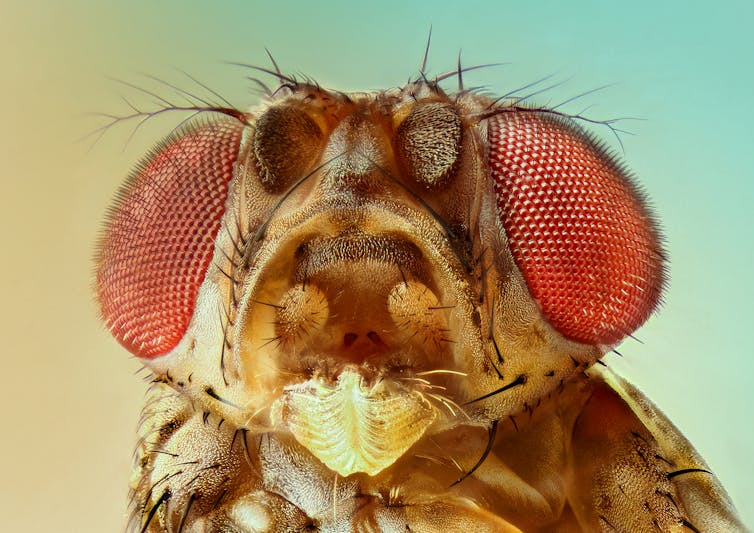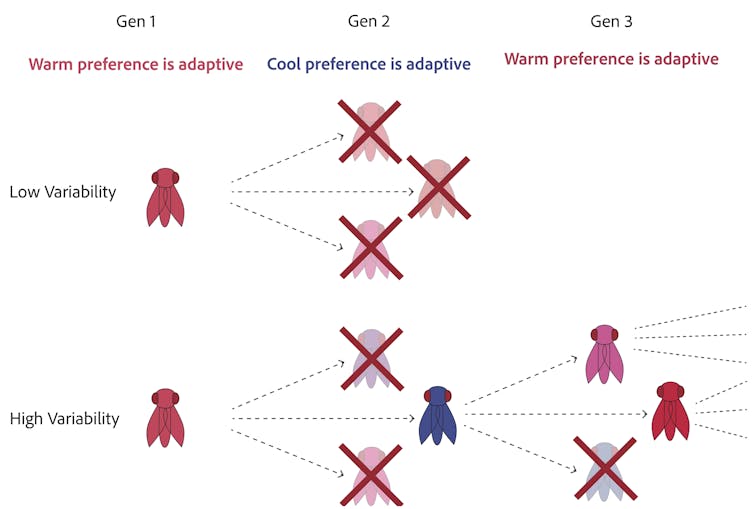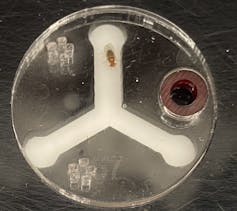As a Ph.D. scholar, I wished to know the evolution of particular person variations in fruit fly conduct – the constructing blocks of persona. My experiments concerned measuring how my tiny topics acted in a maze.
So every day within the lab started with utilizing a skinny paintbrush to carry a single, anesthetized fruit fly and switch it right into a easy maze. After it wakened and had explored the maze, I’d place the fly – cautious to not let it escape in transit – again right into a tube the place it might eat and hang around whereas I made a decision its destiny.
My labmates and I repeated that course of repeatedly, finally measuring the conduct of 900 particular person flies each day.
As many as 1,500 flies stay in every of those Drosophila inhabitants cages. The bottles inside comprise the meals medium they eat and lay eggs on. Researchers can attain within the aspect to extract fruit flies.
Shraddha Lall
I listened to numerous podcasts and audiobooks over many days of transferring a number of flies round by hand and holding monitor of their particular person identities, however this wasn’t how I’d initially deliberate this experiment. I had been excited to work with MAPLE, my lab’s robotic, to automate the primary and final steps of the method. MAPLE would seize particular person flies, safely transfer them into their very own tiny mazes, and again out after I’d measured their behaviors.
I’d been attempting for months to switch MAPLE’s code. I lastly received it operating easily – after which on Day 1 of my 500-day experiment, MAPLE didn’t work.
MAPLE laborious at work transferring flies into Y-mazes.
After just a little little bit of panic, and numerous deep respiration, I made a decision to energy by way of with out the robotic’s assist. MAPLE’s refusal to cooperate was the primary of many obstacles I confronted as I continued my experiment for the subsequent yr and a half. Throughout this time, I realized rather a lot concerning the constructing blocks of persona – in addition to the challenges of doing scientific analysis and learn how to work round them.
Animals have personalities
As an evolutionary biologist who research animal conduct, I’m fascinated that no two people are utterly alike. Take into consideration the animal mates in your life — cats and canines have distinctive personalities and idiosyncrasies, whether or not it’s a selected meals they hate or a specific method they prefer to nap.
All animals – from the smallest worm to the most important whale – have personalities: particular person behavioral preferences that stay roughly secure all through their lifetime. In Drosophila melanogaster, the fruit flies I labored with, individuality is clear in easy binary behaviors. Particular person flies present a choice for turning left or proper, selecting a sizzling or cool setting, preferring brightly lit areas or the shade, and lots of different idiosyncrasies.
Each nature and nurture affect animal persona. The setting throughout improvement can play a vital position in some situations. In others, genes inherited from mother and father can drive preferences. In sure populations of fruit flies, for instance, mother and father that like sizzling temperatures improve the probabilities that offspring favor sizzling temperatures.

All animals, together with fruit flies, have particular person preferences which can be the constructing blocks of their personalities.
vasekk/iStock through Getty Photographs Plus
It’s also potential for genes to affect how a lot people differ from one another. For example, sure mixtures of genes can lead particular person fruit flies to have broadly completely different temperature preferences, with some liking colder temperatures and others preferring it heat. These genes decide how broad the vary of temperatures a person’s preferences are drawn from.
Scientists have discovered genes that affect variation in traits in lots of animals and crops, so evolution appears to have stored them round for a cause. However what’s the good thing about a gene that makes people inside a gaggle completely different from one another?
The advantages of variation
An evolutionary idea referred to as bet-hedging means that in an unpredictable setting, having choices might be much less dangerous. When situations are fluctuating, there isn’t a one conduct that’s greatest fitted to the setting. Variability-influencing genes might be adaptive on this scenario.
Take temperature choice, for instance.
Think about that an organism can have both a low temperature-variability gene, which I’ll name low-var, or a excessive temperature-variability gene, high-var. Animals with the low-var gene have comparable temperature preferences and might all survive and reproduce when the setting has secure, common temperatures. Comparatively, animals with high-var have very completely different temperature preferences from one another.
When the setting has common, secure temperatures, the choice of some animals with the high-var gene could also be a great match for situations. They’ll be capable to reproduce, however many different high-var people could not.
Nevertheless, if temperatures fluctuate unpredictably, going beneath or above the common, all of the low-var animals can be unfit and unable to move on their genes. The low-var inhabitants would utterly collapse.
Within the high-var group, regardless of how the setting fluctuates, there could be some people whose explicit temperature choice makes them in a position to survive, reproduce and move on the high-var gene.

Wager-hedging idea explains how a gene growing variability might be helpful when the setting fluctuates. Within the first era, the low- and high-variability flies are well-suited to a heat setting. Within the second era, the setting is cool and the low-variability offspring aren’t match for the situations, whereas not less than one fly from the high-variability line is.
Shraddha Lall
The competitors underlying evolution is a struggle for which genes win out and are in a position to persist over time. In fluctuating environments, a gene that makes the people variable throughout a sure trait, comparable to temperature choice, has a greater probability of persisting long run. Populations with these sorts of bet-hedging genes can due to this fact have the next probability of surviving in unpredictable environments.
How can evolution form this variation, and what sorts of genes are concerned? To reply this query, I turned to synthetic choice. This course of is akin to how people have domesticated crops and animals for millennia. An experimenter screens people from a inhabitants for a trait of curiosity, and solely people who meet a sure threshold are allowed to breed to create the subsequent era. As a substitute of nature deciding who survives, the researcher chooses.
Variability in conduct responds to evolution
To evolve excessive variability, I picked a easy conduct: flip bias. When given a selection to show left or proper in a Y-shaped maze, some flies nearly all the time select left, others nearly all the time select proper, and others select left typically and proper typically. These preferences stay secure over their lifetime, and their genetic background performs a task in figuring out it.

Which method will the fruit fly go, left or proper?
Shraddha Lall
Whereas the actual flip bias will not be inherited – a left-turning mother and a left-turning dad don’t essentially make left-turning fly infants – the variability in flip bias might be influenced by genes. This potential for variability might be thought-about the fly’s “personality” – whether or not that’s a powerful choice for one path or a extra versatile method.
For 21 generations, I used video and a sort of AI referred to as pc imaginative and prescient to trace 1000’s of flies. I centered on siblings that shared a mom. If a sibling group made very comparable flip decisions, they probably had low-variability genes. If a gaggle of siblings was combined by way of how biased they had been for turning left or proper, it was probably their lineage had a high-variability gene.
The following step was the unreal choice. I’d select the households probably to have the high-variability genes to mate and produce the subsequent era.
Laptop imaginative and prescient can monitor particular person flies in mazes and report their actions.
On the finish of my experiment, I had developed populations with very excessive ranges of turn-bias variability. My outcomes confirmed that variability in traits and elevated individuality in behaviors can evolve in response to choice, positively within the lab and doubtlessly additionally in nature.
Now, I’m engaged on determining what occurred to their genes because the flies developed, and the way their our bodies and brains might need modified once I compelled them onto this evolutionary path.
Making a world the place bet-hedging dominates
I now knew that elevated behavioral individuality can evolve. That’s, flies can evolve differing personalities pushed by choice. May I recreate within the lab the environmental situations that may result in this evolution in nature?
Fruit flies are ectotherms, that means they should get warmth from exterior sources. Their temperature choice ensures that they discover a appropriate setting to stay and lay eggs in. In a world with growing unpredictability in temperatures, bet-hedging methods could evolve as animals adapt.
Primarily based on bet-hedging idea, I hypothesized that evolving in an unpredictable thermal setting within the lab, with temperatures fluctuating over generations, would result in the evolution of upper variability in temperature preferences.
With this in thoughts, a labmate and I started creating homes for flies the place we might management temperatures of various areas and alter them over time. Sadly, time and logistics stopped this experiment, and it sits in storage now. I hope to proceed this work sometime.
My fly experiments taught me rather a lot about how animal conduct evolves, and likewise rather a lot concerning the means of doing analysis. There have been two constants – first, typically issues don’t work out, and that’s OK. And second, whatever the challenges – together with damaged robots, lengthy hours and paused experiments – I wish to hold exploring how evolution can form persona as animals adapt to altering environments.


